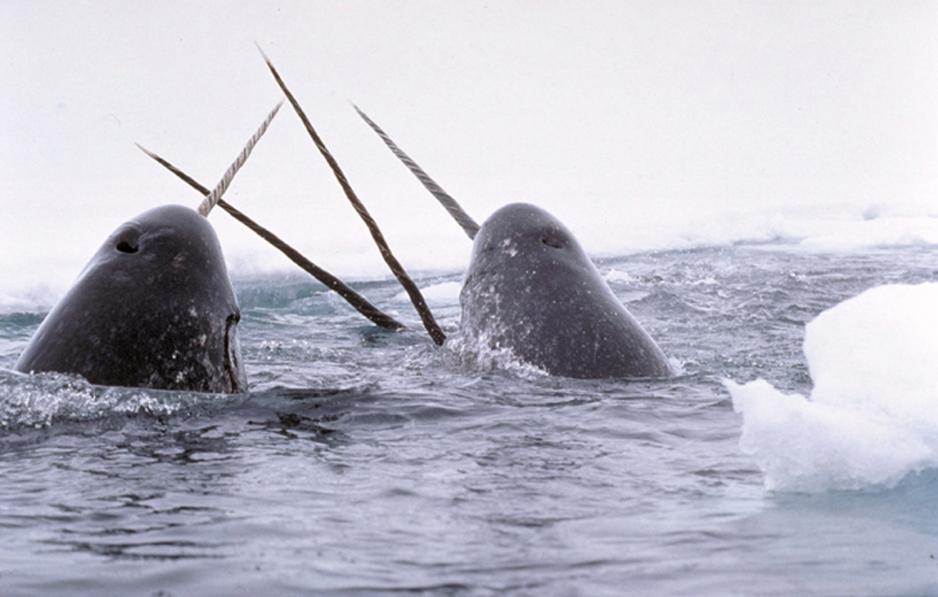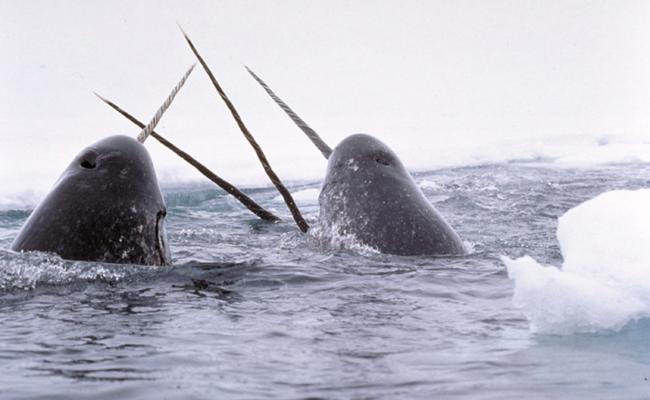Arctic Whales Impacted by Continued Increase in Maritime Traffic

The narwhal is an important resource in Inuit culture. (Photo: Wikipedia)
Marine vessel traffic in the Arctic is increasing and often overlaps with Arctic whale ranges, say researchers. Due to Arctic industrialization and ice-free waters, narwhal, beluga, and bowhead whales are increasingly being exposed to impactful activities.
A recent research article titled Narwhal, beluga and bowhead whale responses to marine vessel traffic: A systematic map by Emily L. Hague (Heriot-Watt University) and Lauren H. McWhinnie (University of Victoria) explores the increase in marine vessel traffic and how Arctic whales respond to marine vessels and vessel-associated activities.
Because of the growing industrialization of the Arctic, in addition to increasingly ice-free waters making the Arctic more accessible, the whales are being exposed to human activity to a higher degree than before.
The two researchers have conducted a systematic map to determine the understanding of how the three Arctic whale species, narwhal, beluga, and bowhead, are impacted by marine vessels and vessel-associated activities.

The beluga whale Hvaldimir discovered in Hammerfest, Norway in 2019. (Photo: Hvaldimir Foundation)
Lack of knowledge
The two researchers emphasize that there is a lack of knowledge in several areas, which could harm the three Arctic whale species.
Industrialization and developing technology have led to Arctic whales being increasingly exposed to potentially harmful human activities, such as shipping, fishing, and fossil fuel exploration and extraction, according to researchers.
With sea ice melting, the Arctic is no longer as remote and inaccessible as before, which also increases the amount of human activity that the whales are exposed to. However, this area lacks knowledge.
Why is it important to gather more knowledge in this area?
"Many whale populations in the Arctic are still recovering from historic commercial whaling, whilst their habitat and prey also change due to the modern-day threat of climate change. With warming seas leading to increasingly long ice-free periods, the Arctic is becoming increasingly accessible to all types of vessels," says Hague to High North News and continues:
"From cruise tourism to recreational traffic to the movement of large cargo-carrying ships, there is interest in taking advantage of increased accessibility to the Arctic, but this may impact the marine mammals that live there, and have historically been exposed to very little vessel traffic, due to the challenging conditions."
"We know from studies elsewhere that vessels can pose a risk to marine mammals (for example, through collision risk, or alteration of the underwater soundscape), so it’s likely Arctic whales will be affected by vessel traffic, too. By gathering knowledge on the impact of marine traffic on Arctic whales, we can hopefully mitigate the impacts of increasing Arctic traffic."
The three Arctic whale species
- Only three species stay in the Arctic year-round: the beluga, narwhal, and bowhead whales.
- Bowhead whales: Also called Greenland whales, are believed to be among the longest-lived mammals on Earth and can live up to 200 years. Can reach more than 19 meters in length. Found on both the Atlantic and Pacific sides of the Arctic.
- Beluga whales: Also called white whales, live primarily with sea ice. Extremely sociable, typically move in pods of two to 10 whales. Typically live as long as 80 years.
- Narwhal: Live in the Arctic waters of Canada, Greenland, Norway and Russia. Known for its long ivory tusk. Can reach up to 2.5 meters in length.
- All three species are threatened by climate change and increased industrial activities, especially shipping.
Source: the Arctic WWF
Recommends studies on increasing vessel types
The researchers state that several vessel types are increasingly present in the Arctic, such as cruise ships and fishing vessels, yet receive limited consideration.
There was more research on oil and gas-related vessels and goods ships than on other vessel types, while fishing vessels and cruise ships, for example, had far fewer studies documenting the whales' response to these specific vessel types.
As traffic involving these vessel types is increasing in the Arctic, more research is needed on how it impacts the three Arctic whale species, particularly because they have, insofar, received limited exposure to these types of vessels.
Since time immemorial, Arctic whales have formed an essential component of the survival, culture, identity and unique heritage for many Arctic communities.
Considering the cost and scope, do you consider it possible to conduct such specific studies as recommended in your article?
"There are many challenges to Arctic research – including challenging conditions, limited study periods, and elevated costs. To address the knowledge gaps we identified, it will take a collaborative effort, with Arctic communities, ship operators, engineers, policy-makers and governments, researchers, funders, and many more, working together towards reducing the human footprint on the Arctic," says Hague to High North News.
The value of Arctic whales
The two researchers also highlight the value of Arctic whales for communities in the High North, meaning that more research on whales would benefit humans as well.
"These whales form an essential component of the survival, culture, identity, and unique heritage of many Arctic communities."
"For many, they provide sustenance and food security. Ensuring the impacts of vessel traffic on whales are limited will hopefully contribute towards reducing the indirect impacts felt by Arctic communities by rising traffic," concludes Hague.



